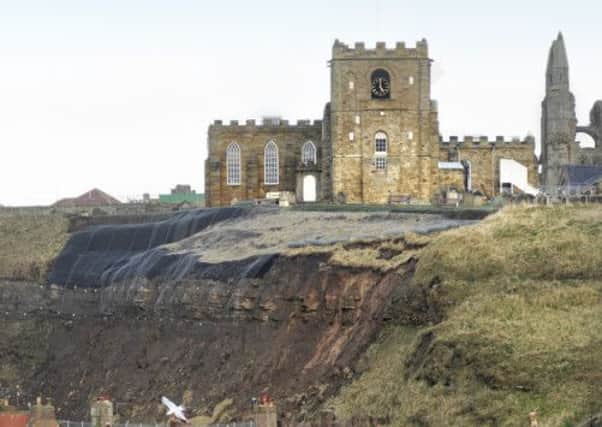‘Work will slow erosion’ near famous Whitby church


Work has been taking place to secure the cliff to try to prevent more landslips under the graveyard of the Yorkshire church which inspired Bram Stoker to write his classic novel, Dracula.
Land near the historic church, which overlooks the harbour, dropped away at the end of last year during torrential downpours.
Advertisement
Hide AdAdvertisement
Hide AdThe slips sent land and human bones tumbling down from the church’s graveyard with some debris hitting buildings belonging to the famous Fortune’s Kippers smoking shack in Henrietta Street.
The dramatic impact of the landslip on the local landscape was plain to see and work is being carried out to try to further strengthen the East Cliff in the churchyard.
Landslides along the stretch of the East Cliff above Henrietta Street have been well documented since 1785, with the most recent ones happening in 2000 and December last year.
Andy Borthwick, a senior engineering geologist with Alan Wood Engineers said the work – due to be completed in the next few weeks – would make the area safer but could not entirely safeguard against further slips.
Advertisement
Hide AdAdvertisement
Hide AdHe said: “Its one of those things where we can try and slow down the damage and the processes but we cannot halt it completely,” he said.
But he said the project ensured available modern techniques were used to secure the cliff.
The work has seen rock fall netting installed over the outcropping sandstone in the cliff and long soil nails put in place to bolt the soil into the cliff.
Drainage tubes are also being installed to channel the ground water away from the edge of the cliff, which it is hoped will prevent further slippages.
Advertisement
Hide AdAdvertisement
Hide AdWorkers have had to abseil down the cliffs below the church to do the works.
The work is expected to take slightly longer than expected but Mr Borthwick said this was because engineers were having to work in difficult weather.
But he added: “We are hoping to finish in the next couple of weeks.”
Staff from Alan Wood Engineers investigated the landslip in December last year and recommended that the work took place.
Advertisement
Hide AdAdvertisement
Hide AdExperts say the church is like a dish collecting all the water from the surrounding landscape and forms the point where the water tips into the sea. This in turn has meant that over the years some soil and loose material has slipped over the cliff.
St Mary’s Church sits next to Whitby Abbey, high above the harbour. The church and its graveyard were used as a setting by Stoker in his novel about the vampire.
Thousands of tourists every year trek up the 199 steps which link the church and the abbey to the town below.
Rainwater was left pouring out of the graveyard and down the cliff at the end of last year. The graveyard has been closed to burials since the 18th century.
Advertisement
Hide AdAdvertisement
Hide AdEarlier Stephen Calvert, of Pearce Bottomley Architects, the church’s inspecting architect, said: “When we had the landslip in December, I think some people were worried that the church was in danger of falling off the cliff.Nothing could be further from the truth.
“The landslip in December was actually some 10 metres (32ft) from the tower of the church.
“The church is sat on the East Cliff headland which is a sandstone outcrop covered with a layer of glacial clay that is generally about four metres (13ft) thick.
“It is the edge of this layer that has crumbled at the face of the outcrop which is about 16 metres (52ft) from the church. The rugged face of the outcrop can be clearly seen as you walk the 199 steps and has changed little in hundreds of years.”